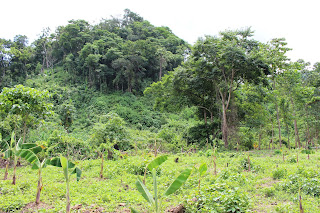The Women of Sitio Calomintao
Waking up to the bucolic rural landscape of Sitio Calomintao is a luxury. The milky, sweet scent of corns radiating from the fields excite the crisp fresh air of the sitio. The sound of the excited feet directs our eyesight to the students on their way to the Calomintao Settlement and Farm School---some wears uniform, some are on their daily t-shirt and short attires. I couldn't remember the excitement of going to school since I started writing my Master's thesis. There must be a good way to have things restarted once you're burnt out. Right now, I can't give you a proper answer, but a cup of coffee sounds nice.
The scorching heat of the month of July worries nanay Caridad Cauayan. We saw her from our tricycle moving her carabao to shade. It must take a lot of strength to move one from one place to another. We were all shocked, even speechless from what we witnessed. The carabao kindly follows her, a connection one begins to flourish if you live in such a peaceful rural area with nothing but the dire need to connect to nature and its elements.
Nanay Juliet Viguilla shares to us her love for plants in her home garden. It is a rather small space for five plants to thrive. She has eggplants, cassava, squash, and the recently harvested string beans laid out next to her small house. She adds a small coconut tree at the southern portion of the yard, and custard apple (guyabano) on the left. A small piece of elegance was added by the 1-meter tall canna lily that sits patiently waiting for her first bloom of the month.
Nanay Betty kindly invites me to her home garden. She has more plants than Nanay Juliet's despite the smaller space she occupied for the garden. She reiterated how one home garden gives so much pride, joy, and food security during the times when economic stability is scarce. I inspected a couple of familiar plants out of curiosity.
The scorching heat of the month of July worries nanay Caridad Cauayan. We saw her from our tricycle moving her carabao to shade. It must take a lot of strength to move one from one place to another. We were all shocked, even speechless from what we witnessed. The carabao kindly follows her, a connection one begins to flourish if you live in such a peaceful rural area with nothing but the dire need to connect to nature and its elements.
Written by: Charl Justine Darapisa
Photos by: Shaira Salazar
Credits to the DENR Mamburao for the field assistance!






Comments
Post a Comment